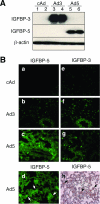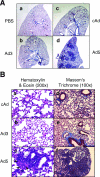Insulin-like growth factor-binding protein-5 induces pulmonary fibrosis and triggers mononuclear cellular infiltration
- PMID: 17071587
- PMCID: PMC1780193
- DOI: 10.2353/ajpath.2006.060501
Insulin-like growth factor-binding protein-5 induces pulmonary fibrosis and triggers mononuclear cellular infiltration
Abstract
We have recently shown that insulin-like growth factor-binding protein (IGFBP)-5 is overexpressed in idiopathic pulmonary fibrosis lung tissues and increases collagen and fibronectin deposition. Here, we further examined the effect of IGFBP-5 in vivo by intratracheal administration of replication-deficient adenovirus expressing human IGFBP-5 (Ad5), IGFBP-3 (Ad3), or no cDNA (cAd) to wild-type mice. Increased cellular infiltration and extracellular matrix deposition were observed in mice after Ad5 administration compared with Ad3 and cAd. Mononuclear cell infiltration consisted predominantly of T lymphocytes at day 8. By day 14, the number of infiltrating T cells decreased, whereas that of B cells and monocytes/macrophages increased. IGFBP-5 also induced migration of peripheral blood mononuclear cells in vitro, suggesting that in vivo mononuclear cell infiltration may be the direct result of IGFBP-5 expression. alpha-Smooth muscle actin and Mucin-1 co-localized in cells of mice treated with Ad5, suggesting that IGFBP-5 induced epithelial-mesenchymal transition. In addition, exogenous IGFBP-5 induced alpha-smooth muscle actin expression in primary fibroblasts and epithelial-mesenchymal transition of pulmonary epithelial cells in vitro. In conclusion, our results suggest that overexpression of IGFBP-5 in mouse lung results in fibroblast activation, increased extracellular matrix deposition, and myofibroblastic changes. Thus, the IGFBP-5-induced fibrotic phenotype in vivo may represent a novel model to better understand the pathogenesis of fibrosis.
Figures





References
-
- American Thoracic Society Idiopathic pulmonary fibrosis: diagnosis and treatment. International Consensus Statement. American Thoracic Society and the European Respiratory Society. Am J Respir Crit Care Med. 2000;161:646–664. - PubMed
-
- Gross TJ, Hunninghake GW. Idiopathic pulmonary fibrosis. N Engl J Med. 2001;345:517–525. - PubMed
-
- Bjoraker JA, Ryu JH, Edwin MK, Myers JL, Tazelaar HD, Schroeder DR, Offord KP. Prognostic significance of histopathologic subsets in idiopathic pulmonary fibrosis. Am J Respir Crit Care Med. 1998;157:199–203. - PubMed
-
- Steen VD, Medsger TA., Jr Severe organ involvement in systemic sclerosis with diffuse scleroderma. Arthritis Rheum. 2000;43:2437–2444. - PubMed
-
- Douglas WW, Ryu JH, Schroeder DR. Idiopathic pulmonary fibrosis: impact of oxygen and colchicine, predonisone, or no therapy on survival. Am J Respir Crit Care Med. 2000;161:1172–1178. - PubMed
Publication types
MeSH terms
Substances
Grants and funding
LinkOut - more resources
Full Text Sources
Other Literature Sources
Medical
Research Materials
Miscellaneous

